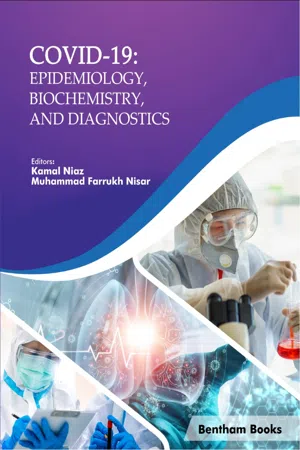
- English
- ePUB (mobile friendly)
- Available on iOS & Android
COVID-19: Epidemiology, Biochemistry, and Diagnostics
About This Book
COVID-19: Epidemiology, Biochemistry, and Diagnostics explains COVID-19 from multidisciplinary angles such as the evolution of SARS-COV, genetic techniques to study the virus, and diagnostic methodologies widely used in the global COVID-19 pandemic. The chapters in this book provide the reader with up-to-date literature about research on SARS-CoV-2 through three parts: I) Evolution and Entry of SARS-CoV-2 into the host II) Genetic Alteration and Structural Determination of SARS-CoV-2 Proteins III) Quantitative Analysis of SARS-CoV-2 for research and medical diagnosis
Key Features: - 15 chapters on SAR-CoV-2 in a multidisciplinary context - Provides a comprehensive overview of SARS-CoV-2 evolution and genetics - Provides biochemical information about SARS-CoV-2 proteins and receptor targets (both structural and non-structural proteins) - Includes an overview of several methods of detecting SARS-CoV-2 virus particles (ELISA, PCR, Neutralizing Antibodies - Covers some critical diagnostic modalities for COVID-19 diagnosis - Provides bibliographic references for further reading
Readers will understand the significance of phylogenetic analysis of coronaviruses, along with the pathogenesis of COVID-19 and related diseases such as SARS and MERS. Applications of biochemical technologies such as RT-PCR and CRISPR are also demonstrated in the text. This book is a comprehensive introduction to COVID-19 research for medical researchers, microbiologists and virologists. Students in academic programs in life sciences and medicine will also benefit from the information provided in the book.
Frequently asked questions
Information
Part I: Evolution and Entry of SARS-CoV-2
Coronavirus Disease-2019 (COVID- 19) Epidemiology
Ihtisham Ulhaq1, Abdul Basit2, Ijaz Ali1, Firasat Hussain3, Zahid Ali1, Faisal Siddique3, Haroon Ahmed1, Amjad Islam Aqib4, Kashif Rahim3, *
Abstract
* Corresponding author Kashif Rahim: Department of Microbiology, Faculty of Veterinary Science, Cholistan University of Veterinary and Animal Sciences (CUVAS), Punjab, Bahawalpur 63100, Pakistan; E-mail: [email protected]
INTRODUCTION
Table of contents
- Welcome
- Table of Content
- Title
- BENTHAM SCIENCE PUBLISHERS LTD.
- FOREWORD
- PREFACE
- List of Contributors
- Part I: Evolution and Entry of SARS-CoV-2
- Coronavirus Disease-2019 (COVID- 19) Epidemiology
- Studying Evolutionary Adaptation of SARS-CoV-2
- Evaluating SARS-CoV-2 Entry Pathways
- Part II: Genetic Alteration and Structural Determination of SARS-CoV-2 Proteins
- Genomic Characterization of SARS-CoV-2
- Mutation of SARS-CoV-2
- Biochemical Characterization of SARS-CoV-2 Spike Protein Proteolytic Processing
- Crystal Structure Determination and Receptor Recognition Basis of SARS-CoV-2 Spike Glycoprotein
- Structural Elucidation of SARS-CoV-2 Accessory Proteins
- Part III: Quantitation Analysis of SARS-CoV-2
- Antigen Capture Enzyme-Linked Immunosorbent Assay (ELISA) for the Detection of the Novel SARS-CoV-2 in Humans
- Quantification of the SARS-CoV-2 RNA in Tissues by Quantitative Real Time-PCR
- Evaluation of SARS-CoV-2 Neutralizing Antibodies in Sera Using Live Virus Microneutralization Assay
- Pseudovirus Neutralization Assay for SARS-CoV-2
- Quantitative and Qualitative Determination of COVID-19 (SARS-CoV-2) Specific Antibodies Using ELISA
- Chest CT Scan: An Ideal Diagnostic Tool for COVID-19
- Nucleic Acid-Based Detection of COVID-19